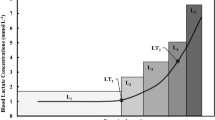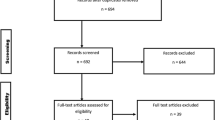Abstract
Gender differences in resting pulmonary function are attributable to the smaller lung volumes in women relative to men. We sought to investigate whether the pattern of response in operational lung volumes during exercise is different between men and women of similar fitness levels. Breath-by-breath volume changes of the entire chest wall ( V̇ CW) and its rib cage ( V̇ Rc) and abdominal ( V̇ Ab) compartments were studied by optoelectronic plethysmography in 15 healthy subjects (10 men) who underwent a symptom-limited ( W peak) incremental bicycle test. The pattern of change in end-inspiratory and end-expiratory V̇ CW ( V̇ CW,EI and V̇ CW,EE, respectively) did not differ between the sexes. With increasing workload the decrease in V̇ CW,EE was almost entirely attributable to a reduction in end-expiratory V̇ Ab, whereas the increase in V̇ CW,EI was due to the increase in end-inspiratory V̇ Rc in both sexes. In men, at W peak tidal volume [ V̇ T, 2.7 (0.2) l] and inspiratory capacity [IC, 3.4 (0.2) l] were significantly greater than in women [1.8 (0.2) and 2.6 (0.2) l, respectively]. However, after controlling for lung size using forced vital capacity (FVC) as a surrogate, the differences between men and women were eliminated [ V̇ T /FVC 49 (3) and 45 (3) respectively, and IC/FVC 63 (2) and 65 (3) respectively]. All data are presented as mean (SE). In both men and women the contribution of the rib cage compartment to V̇ T expansion was significantly greater than that of the abdominal compartment. We conclude that gender differences in operational lung volumes in response to progressive exercise are principally attributable to differences related to lung size, whereas compartmental chest wall kinematics do not differ among sexes.




Similar content being viewed by others
References
Aliverti A, Cala SJ, Duranti R, Ferrigno G, Kenyon CM, Pedotti A, Scano G, Sliwinski P, Macklem PT, Yan S (1997) Human respiratory muscle actions and control during exercise. J Appl Physiol 83:1256–1269
Aliverti A, Iandelli I, Duranti R, Cala SJ, Kayser B, Kelly S, Misuri G, Pedotti A, Scano G, Sliwinski P, Yan S, Macklem PT (2002a) Respiratory muscle dynamics and control during exercise with externally imposed expiratory flow limitation. J Appl Physiol 92:1953–1963
Aliverti A (2002b). Optoelectronic plethysmography. In: Aliverti A, Brusasco V, Macklem PT, Pedotti A (eds) Mechanics of breathing. Springer, Milan, pp 47–59
Aliverti A, Stevenson N, Dellaca RL, Lo Mauro A, Pedotti A, Calverley PM (2004) Regional chest wall volumes during exercise in chronic obstructive pulmonary disease. Thorax 59:210–216
Babb TG, Rodarte JR (1991) Lung volumes during low-intensity steady-state cycling. J Appl Physiol 70:934–937
Cala SJ, Kenyon CM, Ferrigno G, Carnevali P, Aliverti A, Pedotti A, Macklem PT, Rochester DF (1996) Chest wall and lung volume estimation by optical reflectance motion analysis. J Appl Physiol 81:2680–2689
Henke KG, Sharratt M, Pegelow D, Dempsey JA (1988) Regulation of end-expiratory lung volume during exercise. J Appl Physiol 64:135–146
Iandelli I, Aliverti A, Kayser B, Dellaca R, Cala SJ, Duranti R, Kelly S, Scano G, Sliwinski P, Yan S, Macklem PT, Pedotti A (2002) Determinants of exercise performance in normal men with externally imposed expiratory flow limitation. J Appl Physiol 92:1943–1952
Johnson BD, Saupe KW, Dempsey JA (1992) Mechanical constraints on exercise hyperpnea in endurance athletes. J Appl Physiol 73:874–886
Jones NL, Makrides L, Hitchcock C, Chypchar T, McCartney N (1985) Normal standards for an incremental progressive cycle ergometer test. Am Rev Respir Dis 131:700–708
Kenyon CM, Cala SJ, Yan S, Aliverti A, Scano G, Duranti R, Pedotti A, Macklem PT (1997) Rib cage mechanics during quiet breathing and exercise in humans. J Appl Physiol 83:1242–1255
Kilbride E, McLoughlin P, Gallagher CG, Harty HR (2003) Do gender differences exist in the ventilatory response to progressive exercise in males and females of average fitness? Eur J Appl Physiol 89:595–602
McClaran SR, Harms CA, Pegelow DF, Dempsey JA (1998) Smaller lungs in women affect exercise hyperpnea. J Appl Physiol 84:1872–1881
Mead J (1980) Dysanapsis in normal lungs assessed by the relationship between maximal flow, static recoil and vital capacity. Am Rev Respir Dis 121:339–342
O’Donnell DE, Webb KA (1993) Exertional breathlessness in patients with chronic airflow limitation: the role of lung hyperinflation. Am J Respir Crit Care Med 148:1351–1357
O’Donnell DE, Revill SM, Webb KA (2001) Dynamic hyperinflation and exercise intolerance in chronic obstructive pulmonary disease. Am J Respir Crit Care Med 164:770–777
Schwartz J, Katz SK, Fegley RW, Tockman MS (1988) Sex and race differences in the development of lung function. Am Rev Respir Dis 138:1415–1421
Sharratt M, Henke KG, Aaron EA, Pegelow DF, Dempsey JA (1987) Exercise-induced changes in functional residual capacity. Respir Physiol 70:313–326
Stubbing DG, Pengelly LD, Morse JLC, Jones NL (1980) Pulmonary mechanics during exercise in normal males. J Appl Physiol 49:506–510
Ward ME, Ward J, Macklem PT (1992) Analysis of human chest wall motion using a two-compartmental chest wall model. J Appl Physiol 72:1338–1347
Yan S, Kaminski D, Sliwinsky P (1997) Reliability of inspiratory capacity for estimating end-expiratory lung volume changes during exercise in patients with chronic obstructive pulmonary disease. Am J Respir Crit Care Med 156:55–59
Younes M, Kivigen G (1984) Respiratory mechanics and breathing pattern during and following maximal exercise. J Appl Physiol 57:1773–1782
Acknowledgements
This work was supported in part by the European Community CARED FP5 project (contract no. QLG5-CT-2002-0893)
Author information
Authors and Affiliations
Corresponding author
Rights and permissions
About this article
Cite this article
Vogiatzis, I., Aliverti, A., Golemati, S. et al. Respiratory kinematics by optoelectronic plethysmography during exercise in men and women. Eur J Appl Physiol 93, 581–587 (2005). https://doi.org/10.1007/s00421-004-1249-4
Accepted:
Published:
Issue Date:
DOI: https://doi.org/10.1007/s00421-004-1249-4




